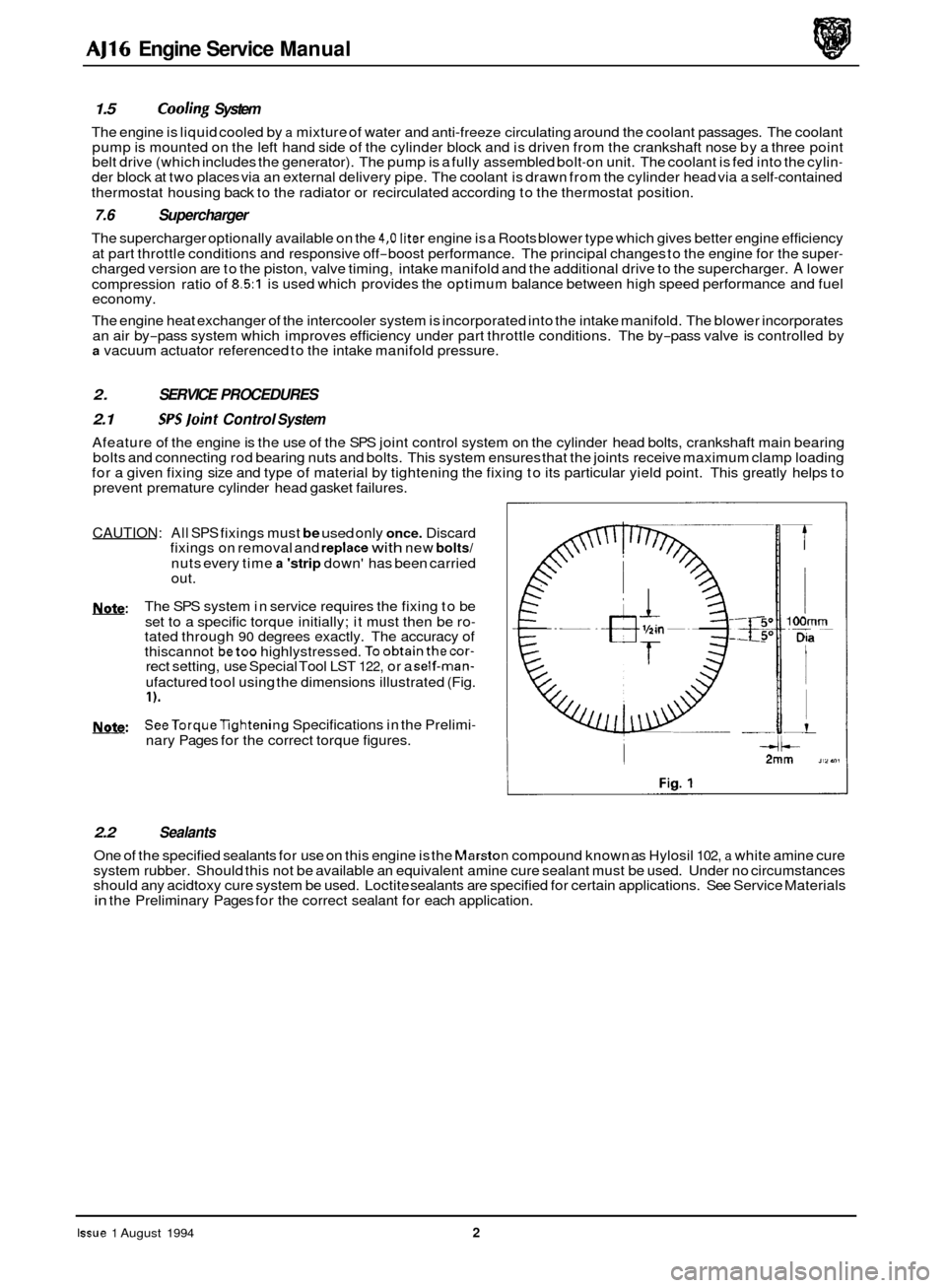dimensions JAGUAR XJ 1994 2.G AJ16 Engine Manual
[x] Cancel search | Manufacturer: JAGUAR, Model Year: 1994, Model line: XJ, Model: JAGUAR XJ 1994 2.GPages: 73, PDF Size: 2.06 MB
Page 21 of 73

AJ16 Engine Service Manual
1.5 Coohg System
The engine is liquid cooled by a mixture of water and anti-freeze circulating around the coolant passages. The coolant
pump is mounted on the left hand side of the cylinder block and is driven from the crankshaft nose by a three point
belt drive (which includes the generator). The pump is a fully assembled bolt
-on unit. The coolant is fed into the cylin- der block at two places via an external delivery pipe. The coolant is drawn from the cylinder head via a self-contained
thermostat housing back to the radiator or recirculated according to the thermostat position.
7.6 Supercharger
The supercharger optionally available on the 4,O liter engine is a Roots blower type which gives better engine efficiency
at part throttle conditions and responsive off
-boost performance. The principal changes to the engine for the super- charged version are to the piston, valve timing, intake manifold and the additional drive to the supercharger. A lower
compression ratio
of 8.5:l is used which provides the optimum balance between high speed performance and fuel
economy.
The engine heat exchanger of the intercooler system is incorporated into the intake manifold. The blower incorporates
an air by
-pass system which improves efficiency under part throttle conditions. The by-pass valve is controlled by a vacuum actuator referenced to the intake manifold pressure.
2. SERVICE PROCEDURES
2.1 SPS )oint Control System
Afeature of the engine is the use of the SPS joint control system on the cylinder head bolts, crankshaft main bearing
bolts and connecting rod bearing nuts and bolts. This system ensures that the joints receive maximum clamp loading
for a given fixing size and type of material by tightening the fixing to its particular yield point. This greatly helps to
prevent premature cylinder head gasket failures.
0
CAUTION: All SPS fixings must be used only once. Discard
fixings on removal and replace with new bolts/
nuts every time a 'strip down' has been carried
out.
The SPS system in service requires the fixing to be
set to a specific torque initially; it must then be ro
- tated through 90 degrees exactly. The accuracy of
thiscannot betoo highlystressed. Toobtainthecor- rect setting, use Special Tool LST 122, or a self-man-
ufactured tool using the dimensions illustrated (Fig.
I).
SeeTorqueTightening Specifications in the Prelimi-
nary Pages for the correct torque figures.
b:
w:
2.2 Sealants
One of the specified sealants for use on this engine is the Marston compound known as Hylosil 102, a white amine cure
system rubber. Should this not be available an equivalent amine cure sealant must be used. Under no circumstances
should any acidtoxy cure system be used. Loctite sealants are specified for certain applications. See Service Materials
in the Preliminary Pages for the correct sealant for each application.
Issue 1 August 1994 2
Page 53 of 73

AJ16 Engine Service Manual
CAUTION: The connecting rod bearing nuts, bolts and
main bearing securing bolts MUST be renewed during assembly and torque tightened as de- scribed in Section 2.1, SPS Joint Control Sys- tem.
. Ensuring that the main bearing caps are marked relative
to the cylinder block, remove the main bearing cap bolts
and remove the caps. Carefully
lift out the crankshaft.
Place the crankshaft
on suitable blocks on a bench. Re- move and discard the bearing shells and the thrust
washers. Clean the cylinder block, crankshaft and bearing
caps.
. Check the crankshaft journals for wear and ovality, for tol- erances - see Service Data in the Preliminary Pages.
. If any ofthe dimensions are outside the stated tolerances,
then the Crankshaft must be renewed.
Fit suitable bolts to the oil gallery plugs and pull to remove
(Fig.
1 ). Check all cylinder block oil galleries for cracks and
blockages. Fit new '0' rings to the oil gallew plugs, lubri- cate the '0' rings and fit the plugs to the cylinder block oil
galleries.
Check all bearing housings for cracks, distortion and any
signs of bearing movement, i.e. scoring or overheating,
renew as necessary.
Checkthecylinder block/cylinder head mating surface for
warping, bowing and cracks.
Check the bore wear in the cylinder block with a suitable
comparator (Fig.
2). This must be done in at least six posi- tions in the bore (Fig. 3).
Maximum bore wear normally occurs towards the
top of the bore, across its thrust axis.
If standard size replacement pistons are being fitted,
they must bethesamegradeasthe markingsonthe
cylinder block.
If new piston
ringsare being fitted without reboring,
de-glaze the cylinder bores using a hone or glaze buster. This operation will not increase the size of
the bores and will givethe bores across-hatchedfin- ish.
&&:
m:
b:
Fia. 1
Fig. 2
1
m2 3
,!I 25s
Fig. 3
34 Issue 1 August 1994